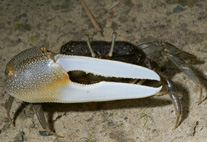Abstract
The scalpellomorph barnacle, Aurivillialepas calycula (Aurivillius, 1898), previously known only from Macaronesia, is reported from Banco de Galicia, off the NW corner of the Iberian Peninsula. One of the two specimens was attached to the scleractinian coral, Madrepora oculata Linnaeus, 1758. Since such pedunculate barnacles are little known, the potentially hermaphroditic specimens and its complemental male are illustrated photographically, and a key to the genus Aurivillialepas is provided. The genus, together with Scillaelepas Seguenza, 1876 and Gruvelialepas Newman, 1980, has long been considered to constitute a natural group of scalpellomorphs within the Calanticidae, and therefore the Scillaelepadinae subfam. nov. is proposed to accommodate them. Biogeographical aspects of these deep-sea barnacles support the hypothesis that not only the islands but the banks and guyots of Macaronesia constitute refugia for ancient as well as more recent forms, some of which may stem back to the late Mesozoic.

